Comet ZTF is fading and receding into the distance. On the other hand, it's now conveniently placed high overhead in early evening in a moonless sky; the waning Moon doesn't rise until late. The comet is crossing Auriga and Taurus on its way toward Orion's shield. It peaked in brightness on February 1st at about magnitude 5.0. As of February 9th it was down to about 6.1. That evening, using 10 x 50 binoculars under a mediocre suburban sky, I could just detect it near Iota Aurigae as a vague, diffuse enhancement of the sky background. Averted vision helped.
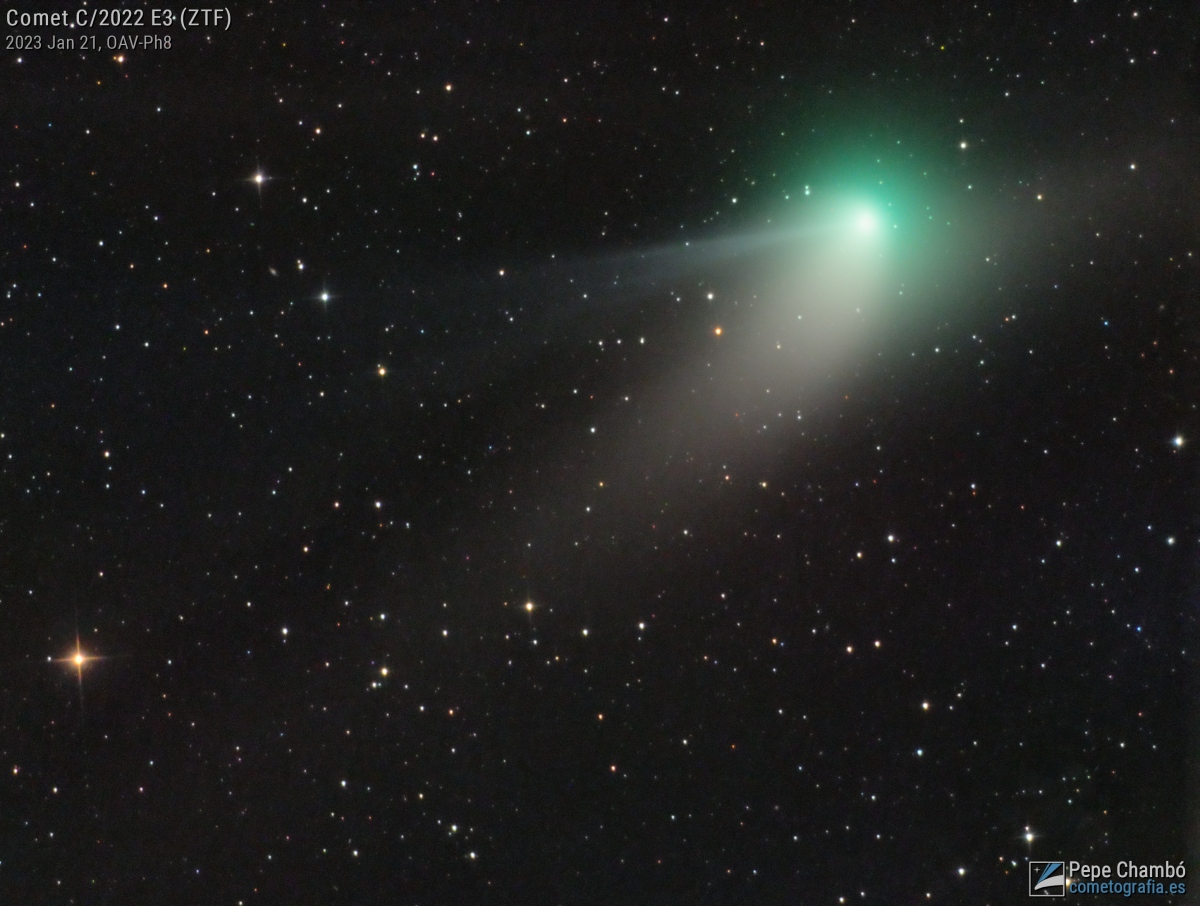
The comet is heading south after its swing past the Little Dipper in late January. Bob King's new article Understanding the Tails of Comet ZTF has a finder chart to use in February. (On that chart, the comet symbols are labeled with the dates for evenings in North America, not the UT dates.)
When the comet becomes too faint for that chart to suffice, use the more detailed one in the February Sky & Telescope, page 48 (where the dates are for 0:00 UT; subtract one day from those to get the North American civil date).
On the evenings of February 10th and 11th the comet will be less than 2° from bright Mars. By then it will probably be about mag 6.4, which is some 300 times fainter than Mars. And of course the comet's light is much more spread out ("diffuse").
It should be down to 7.5 by February 17th.
FRIDAY, FEBRUARY 10
■ Sirius the Dog Star blazes in the southeast after dinnertime, below Orion. It's the brightest star of Canis Major. In a dark sky with lots of stars visible, the constellation's points can be connected to form a convincing Big Dog profile. He's currently standing on his hind legs. Sirius is on his chest, to the right or lower right of his faint triangular head.
But through the light pollution under which most of us live, only his five brightest stars are easily visible. These form the Meat Cleaver. Sirius is the cleaver's top back corner, its blade faces right, and its short handle is down below pointing lower left.
■ Comet ZTF passes Mars this evening and tomorrow evening. Although the comet has dimmed to about magnitude 6.3, binoculars should still show it if you have a good dark sky. The Moon doesn't rise until about 10 or 11 p.m.
Right after the end of twilight, face south and look very high, almost overhead. The comet is 1.6° upper left of Mars, at the top of the "s" in "Mars" in the diagram below (for evening in North America). Tomorrow evening, Saturday, the comet will be 1.8° below Mars.
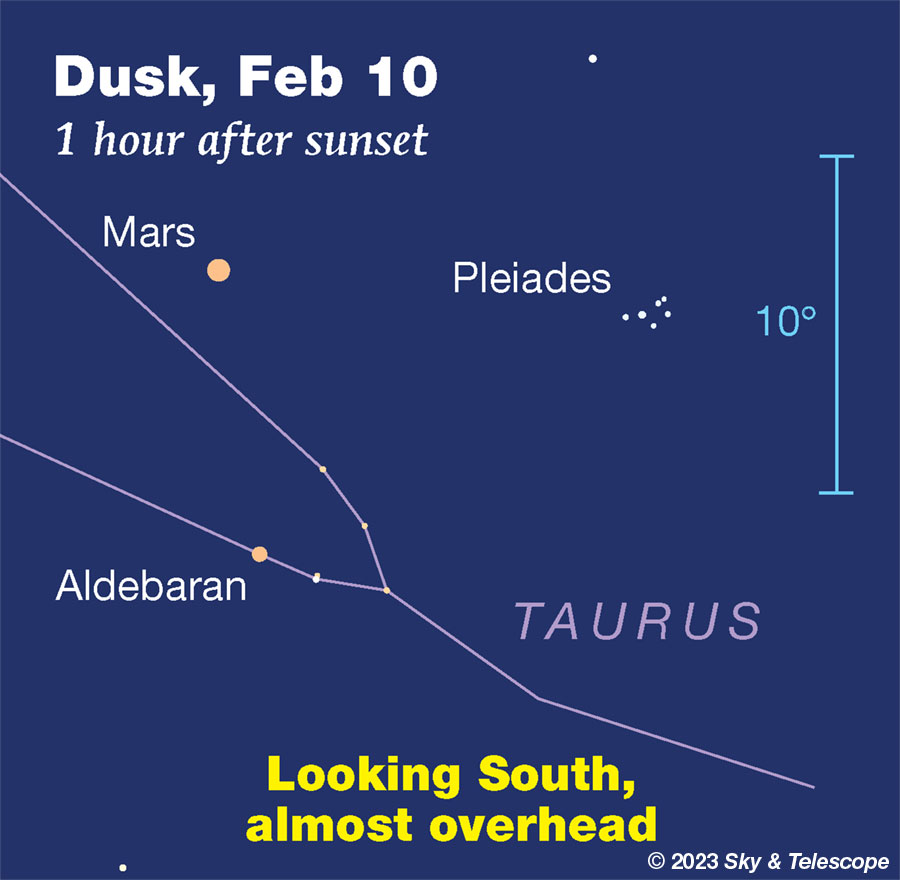
The orientation of this scene changes as the night grows late. The whole array will seem to rotate clockwise as it moves lower toward the west.
■ The waning gibbous Moon rises late Friday night, with 1st-magnitude Spica about 3° to its right or lower right as shown below.
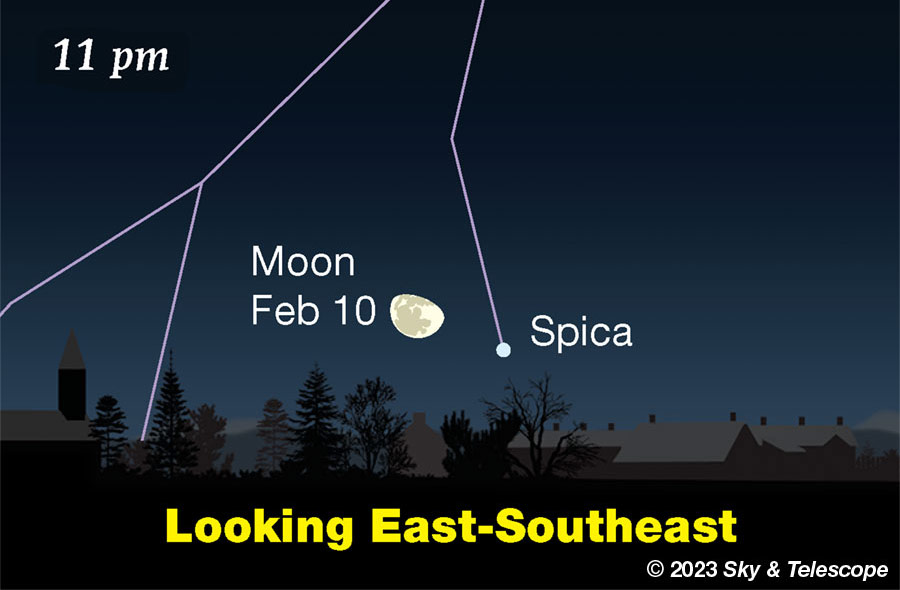
SATURDAY, FEBRUARY 11
■ Right after nightfall this week, the W of Cassiopeia shines high in the northwest standing almost on end.
The brightest star between Cassiopeia and the zenith right after dark, as seen from the world's mid-northern latitudes, is Alpha Persei (Mirfak), magnitude 1.8. It lies on the lower-right edge of the Alpha Persei Cluster: a large, elongated, very loose scatter of fainter stars about the size of your thumbtip at arm's length. At least a dozen are 6th magnitude or brighter. They show best in binoculars. Some of them form a distinctive curving arc focused on Alpha Persei.
Alpha Per, a white supergiant, is a true member of the group and by far its brightest light. It and the rest are about 560 light-years away.
SUNDAY, FEBRUARY 12
■ High in the northern sky these evenings, in the seemingly empty wastes between Capella overhead and Polaris due north, sprawls big, dim Camelopardalis, the Giraffe — perhaps the biggest often-visible constellation you don't know. Unless you have a really dark sky, you'll need binoculars to work out its loose, faint, nondescript pattern using the constellation chart in the center of Sky & Telescope — a challenge project that will build your skills for correctly relating what you see in binoculars to what you see, much smaller, on a sky map.
If you're new at this, start with brighter, easier constellations and save the shy Giraffe until you get good at it.
MONDAY, FEBRUARY 13
■ Last-quarter Moon, exactly so at 11:01 a.m. today. But the Moon doesn't rise until late tonight, around 2 a.m., in the head of Scorpius. By the time Tuesday's dawn begins it's high in the south-southeast and already slightly less than half lit, as shown below.
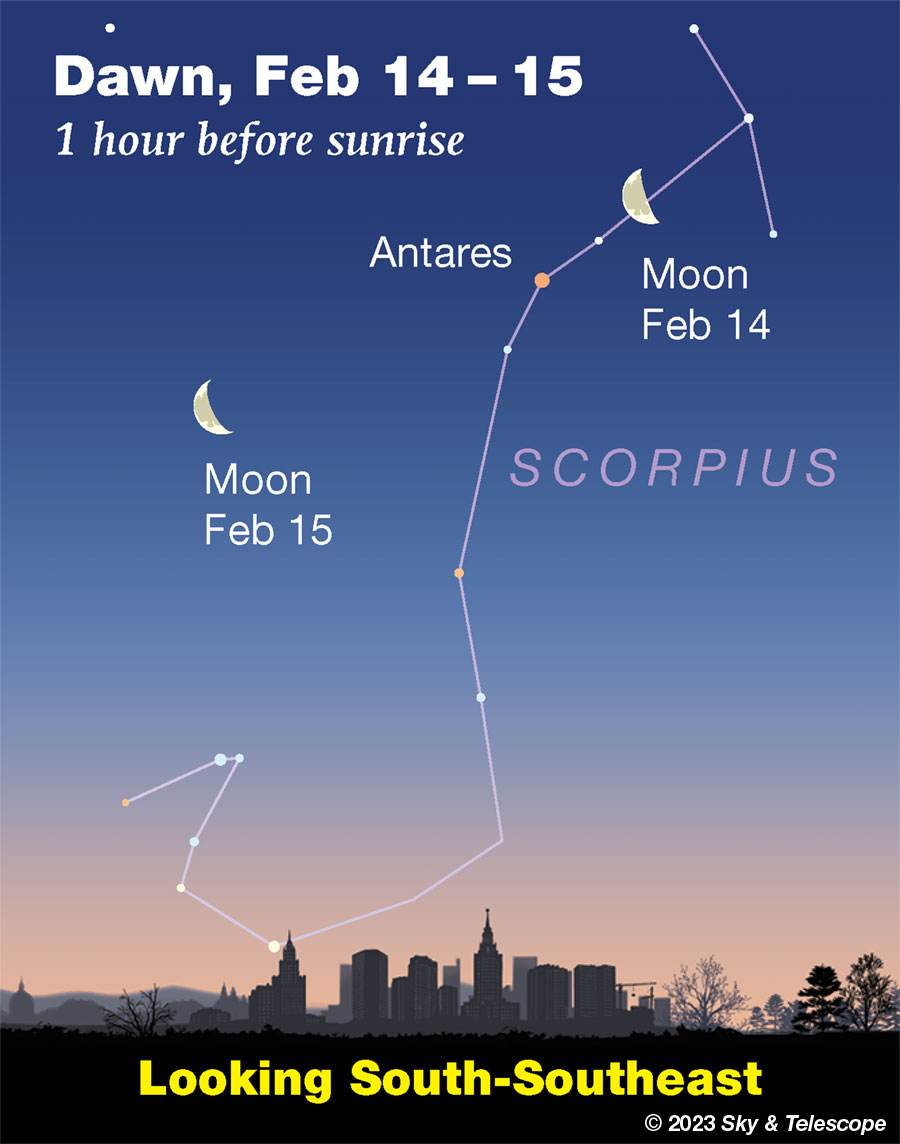
■ Algol should be at its minimum brightness, magnitude 3.4 instead if its usual 2.1, for a couple hours Monday night centered on 11:02 p.m. EST; 8:02 p.m. PST. Algol takes several additional hours to fade and to rebrighten.
TUESDAY, FEBRUARY 14
■ After it’s good and dark, look due east, not very high, for twinkly Regulus. Extending upper left from it is the dimmer Sickle of Leo, a backward question mark. "Leo announces spring," goes an old saying. Actually, Leo showing up in the evening announces the cold, sloggy back half of winter. Come spring, Leo will already be high.
WEDNESDAY, FEBRUARY 15
■ Spot the big, bright, equilateral Winter Triangle in the south-southeast. Sirius is its brightest and lowest star. Betelgeuse is above Sirius by about two fists at arm's length. To their left shines Procyon.
Can you discern their colors? Sirius (spectral type A0) is cold white, Betelgeuse (M2) is yellow-orange, and Procyon (F5) is white with just a slight touch of yellow.
■ The inside of the Winter Triangle is mostly filled by the front half of Monoceros, the dim Unicorn. It always trots across the sky behind Orion. With the Moon out of the evening sky, now's a fine time to trace out the Unicorn's big, dim stick figure. Use the constellation chart in the center of the February or March Sky & Telescope.
Many binocular starwatchers know about its distinctive star cluster NGC 2244, a boxy little rectangular pattern in the center of the vastly dimmer Rosette Nebula. It's right about where the Unicorn's eye might be in his triangular head. The brightest stars of the box pattern are 6th and 7th magnitude. Find them 10° to the celestial east-southeast of Betelgeuse. The elongated rectangle currently stands upright.
If you've got big binoculars or a small telescope, try next for the larger but fainter Christmas Tree Cluster, NGC 2264, at 15 Monocerotis: the 5th-magnitude star marking the tip of the Unicorn's horn above the back of his head. The stars outlining the Christmas Tree are only 7th and 8th magnitude. The tree currently hangs downward from its base, marked by 15 Mon. See Matt Wedel's Binocular Highlight column and map in the February 2022 issue of Sky & Telescope, page 43.
THURSDAY, FEBRUARY 16
■ Orion stands his highest in the south by 7 or 8 p.m., looking smaller than you probably remember him appearing early in the winter when he was low. You're seeing the "Moon illusion" effect. Constellations, not just the Moon, tend to look bigger when they're low and smaller when they're high.
Under Orion's feet, and to the right of Sirius now, hides Lepus the Hare. Like Gemini and Canis Major, this is a constellation with a connect-the-dots that really looks like what it's supposed to be. He's a crouching bunny, with his nose pointing lower right, his faint ears extending up toward Rigel (Orion's brighter foot), and his body bunched to the left. His brightest two stars, 3rd-magnitude Alpha and Beta Leporis, form the back and front of his neck.
■ Algol should be at its minimum for a couple hours centered on 7:51 p.m. EST.
FRIDAY, FEBRUARY 17
■ Jupiter and Venus are closing in on each other in the western twilight, as shown below. They're on their way to a head-turning conjunction on March 1st. That evening they'll be ½° apart and lined up horizontally. Mark your calendar.
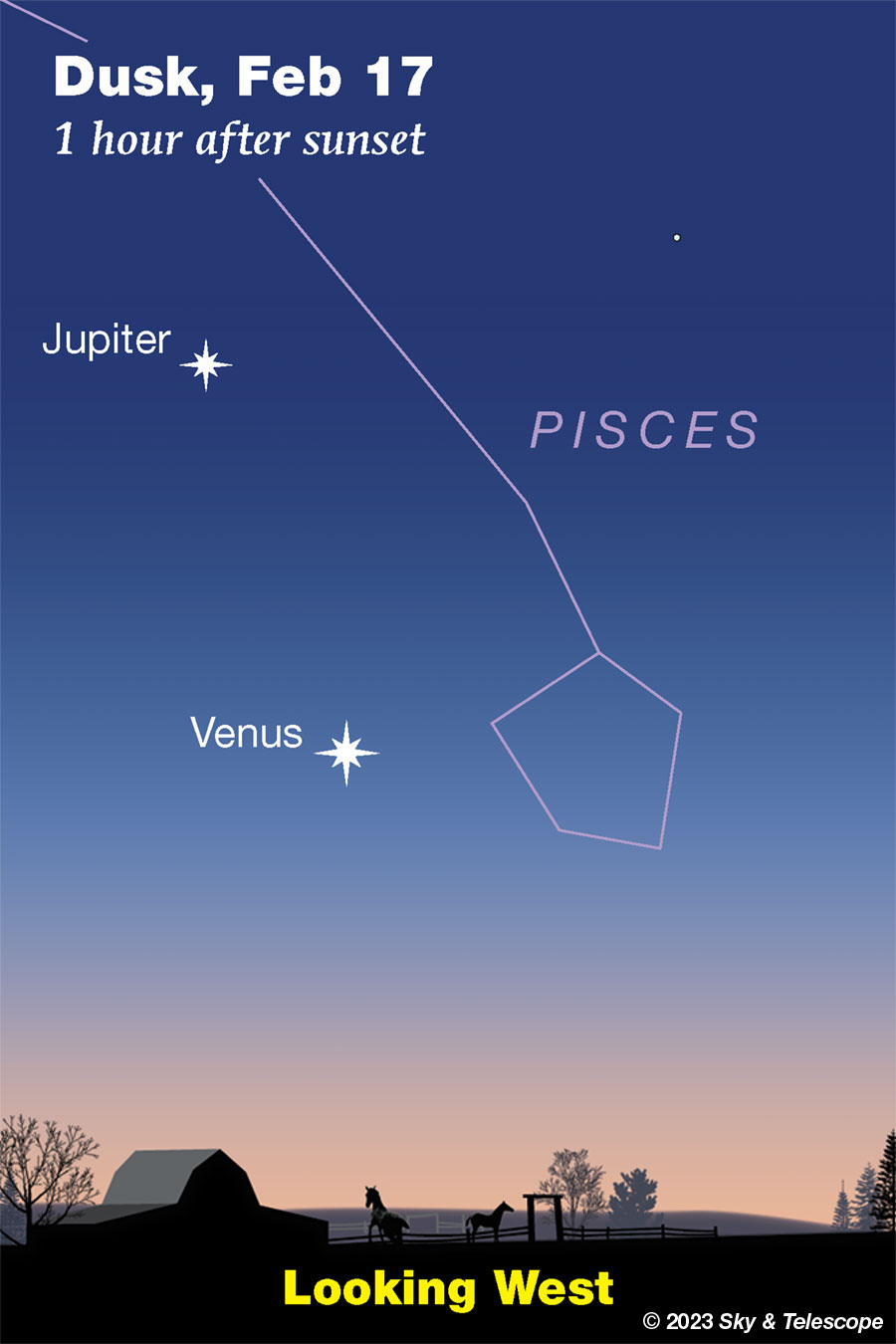
SATURDAY, FEBRUARY 18
■ By 9 p.m. or so, the Big Dipper stands on its handle well up in the northeast. In the northwest, Cassiopeia also stands on end (its brighter end) at about the same height. Between them is Polaris.
SUNDAY, FEBRUARY 19
■ Have you ever seen Canopus, the second-brightest star after Sirius? Canopus lies almost due south of Sirius: by 36°. That's far enough south that it never appears above your horizon unless you're below latitude 37° N (southern Virginia, southern Missouri, central California). And there, you'll need a very flat south horizon. Canopus crosses the south point on the horizon just 21 minutes before Sirius does.
When to look? You'll know Canopus is due south when Beta Canis Majoris — Murzim the Announcer, the star about three finger-widths to the right of Sirius — is at its highest due south over your landscape. That's about 8 p.m. now, depending on how far east or west you are in your time zone. Drop straight down from Murzim then.
This Week's Planet Roundup
Mercury is disappearing into the eastern glow of sunrise.
Venus and Jupiter, the two brightest planets, shine boldly in the west-southwest at dusk. Venus is the lower and brighter one; they're magnitudes –3.9 and –2.1, respectively.
On Friday the 10th they're still 20° apart, but they're closing fast. A week later on the 17th they're only 12° apart. They're on their way to a close conjunction on March 1st, when they'll be half a degree apart.
Telescopically Venus is a shimmering little ball, 11 or 12 arcseconds in diameter and slightly gibbous (89% sunlit). Jupiter is 35 arcseconds wide (small for Jupiter) and displays a strikingly dimmer surface brightness in a telescope. It's nearly 7 times farther from the Sun than Venus is.
Mars, in Taurus, shines very high toward the south in early evening, almost overhead. It moves lower toward the west as evening grows late. Mars continues to fade, from magnitude 0.0 to +0.2 this week, and is 10 or 9 arcseconds wide. It too is gibbous, 91% sunlit, as seen below.
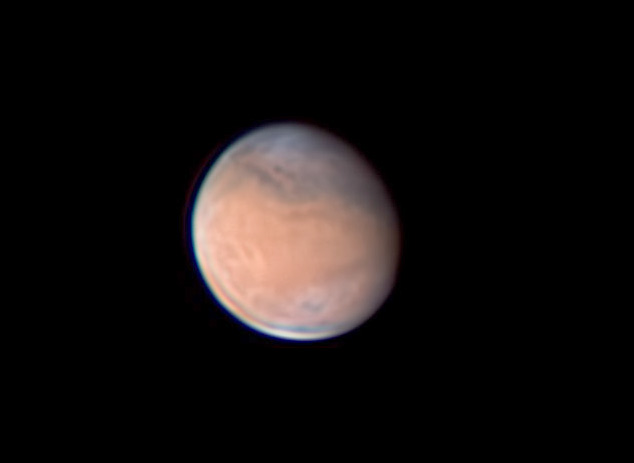
Spot Aldebaran, magnitude +0.8, below Mars (by 9°) in early evening. Later in the evening it's lower left of Mars.
Saturn is out of sight in conjunction behind the Sun.
Uranus, magnitude 5.8 in southern Aries, is high in the southwest in early evening. It displays a tiny, very slightly blue-greenish gray disk 3.6 arcseconds wide. It a telescope at high power it's definitely non-stellar. See the Uranus finder charts in the November Sky & Telescope, page 49.
Neptune, magnitude 8.0 at the Aquarius-Pisces border, is essentially unobservable in the vicinity of Venus. First twilight is too bright, then by dark Neptune is too low.
All descriptions that relate to your horizon — including the words up, down, right, and left — are written for the world's mid-northern latitudes. Descriptions and graphics that also depend on longitude (mainly Moon positions) are for North America.
Eastern Standard Time (EST) is Universal Time minus 5 hours. Universal Time is also called UT, UTC, GMT or Z time.
Want more sky scenes? Use our Interactive Sky Chart to get sky views in any direction, for any date, any time, and any location on Earth!
Want to become a better astronomer? Learn your way around the constellations. They're the key to locating everything fainter and deeper to hunt with binoculars or a telescope.
This is an outdoor nature hobby. For a more detailed constellation guide covering the whole evening sky, use the big monthly map in the center of each issue of Sky & Telescope, the essential magazine of astronomy.
Once you get a telescope, to put it to good use you'll need a much more detailed, large-scale sky atlas (set of charts). The basic standard is the Pocket Sky Atlas (in either the original or Jumbo Edition), which shows all stars to magnitude 7.6.

Next up is the larger and deeper Sky Atlas 2000.0, plotting stars to magnitude 8.5; nearly three times as many. The next up, once you know your way around, are the even larger Interstellarum atlas (stars to magnitude 9.5) or Uranometria 2000.0 (stars to magnitude 9.75). And be sure to read How to Use a Star Chart with a Telescope. It applies just as much to charts on your phone or tablet as to charts on paper.
You'll also want a good deep-sky guidebook. A beloved old classic is the three-volume Burnham's Celestial Handbook. An impressive more modern one is the big Night Sky Observer's Guide set (2+ volumes) by Kepple and Sanner.
Can a computerized telescope replace charts? Not for beginners, I don't think, and not on mounts and tripods that are less than top-quality mechanically. And as Terence Dickinson and Alan Dyer say in their Backyard Astronomer's Guide, "A full appreciation of the universe cannot come without developing the skills to find things in the sky and understanding how the sky works. This knowledge comes only by spending time under the stars with star maps in hand."
![]() Audio sky tour. Out under the evening sky with your
Audio sky tour. Out under the evening sky with your
earbuds in place, listen to Kelly Beatty's monthly
podcast tour of the heavens above. It's free.
"The dangers of not thinking clearly are much greater now than ever before. It's not that there's something new in our way of thinking, it's that credulous and confused thinking can be much more lethal in ways it was never before."
— Carl Sagan, 1996
"Facts are stubborn things."
— John Adams, 1770
 11
11









Comments
Rod
February 10, 2023 at 6:51 am
I was able to view the comet again last evening. [Observed 1900-1940 EST. Last Quarter Moon 13-Feb-2023 1601 UT. Waning gibbous Moonrise tonight in Virgo 2128 EST. C/2022 E3 (ZTF) easy to see using 10x50 binoculars tonight, located in Taurus. Mars and C/2022 E3 (ZTF) angular separation about 4-degree 46 arcminutes according to Stellarium 1.2. The comet was nearly mid-way between Hassaleh in Auriga and Mars in Taurus. A distinct fuzzy coma visible in my 10x50 binocular view. I am slowly saying goodbye to this comet as it heads out towards places unknown 🙂 Stellarium 1.2 shows distance from Earth to C/2022 E3 (ZTF) tonight about 0.396 au. Distance to Mars, 0.959 au, and distance to Hassaleh in Auriga, 493.43 ly. An easy observing time this evening using 10x50 binoculars, theskylive.com reports 6.3 magnitude for C/2022 E3 (ZTF) tonight. Stellarium 1.2 shows 6.29, and Starry Night Pro Plus 8 shows 6.29 magnitude. I viewed the comet periodically since 24-Dec-2022. Starry Night Pro Plus 8 Sky Calendar says for 10-Feb-2023. "Comet C/2022 E3 (ZTF) Meets Mars (evening) VIEW On Friday night, February 10, the path of Comet C/2022 E3 (ZTF) is predicted to carry it closely past the bright red planet Mars. The pair will be positioned nearly overhead in the southwestern sky, between the very bright stars Aldebaran in Taurus, the Bull and Capella in Auriga, the Charioteer. Mars and the comet will be close enough to share the field of view in binoculars and widefield telescopes. The comet will have faded from its predicted peak brightness, but it should still be visible in binoculars. Comet C/2022 E3 (ZTF) will be closest to Mars during the hours around 7 a.m. EST (or 11:00 UT on February 11), but it will have set by 3 a.m. local time in the Americas."]
You must be logged in to post a comment.
Rod
February 10, 2023 at 8:10 pm
Some more comet viewing tonight, now closer to Mars in Taurus.
Observed 1900-1945 EST. Last Quarter Moon 13-Feb-2023 1601 UT. Waning gibbous Moonrise tonight in Virgo 2231 EST. C/2022 E3 (ZTF) easy to see using 10x50 binoculars tonight, located in Taurus. Mars and C/2022 E3 (ZTF) angular separation about 1-degree 41 arcminutes according to Stellarium 1.2. A distinct fuzzy coma visible in my 10x50 binocular view, brighter nucleus, still a good size in my binocular view. Stellarium 1.2 shows distance from Earth to C/2022 E3 (ZTF) tonight about 0.419 au. Distance to Mars, 0.969 au. I could see the comet and Mars together in the binocular view. Perhaps some will get a photo of this pairing tonight, theskylive.com reports 6.5 magnitude for C/2022 E3 (ZTF) tonight. Stellarium 1.2 shows 6.44. Some altocumulus and cirrus clouds moved in, so I did not use my telescopes (90-mm refractor or 10-inch Newtonian.) Temperature 8C, winds 360/8 knots. I did see the comet closer to Mars position tonight and that was enjoyable using binoculars.
You must be logged in to post a comment.
PGT
February 10, 2023 at 9:57 pm
For someone who lives in a light-polluted Maryland suburb (of Annapolis), is there a website out there that shows a live cam of the sky from a dark location?
You must be logged in to post a comment.
PGT
February 10, 2023 at 9:58 pm
Second quick question: missing Pluto! I've recently found https://theskylive.com/pluto-tracker. Is that the best site for keeping tabs on the little guy?
You must be logged in to post a comment.
Rod
February 11, 2023 at 7:11 am
PGT, I live south of Annapolis MD along the Patuxent River farms (more farm and open space areas) so not as bad as a more urban area, no streetlights around or other bright lighting. 🙂 I use theskylive.com site frequently and find it useful, a variety of solar system targets tracked, you can use your location with the site too, so charts are visible for your location and time. I use Stellarium and Starry Night Pro Plus 8. Stellarium is free download. http://stellarium.org/ The software works very well; I use a 90-mm refractor telescope and 10-inch Newtonian too.
You must be logged in to post a comment.
Rod
February 13, 2023 at 8:52 pm
I did enjoy some more comet views tonight using my 10-inch Newtonian.
Observed 1800-2000 EST. Last Quarter Moon 13-Feb-2023 1601 UT. I enjoyed some very good views of C/2022 E3 (ZTF) this evening using the XT10i with TeleVue 35-mm PO. 34x and true FOV about 1.8-degrees. The 10-inch presented a brighter image and easier to see than my 90-mm refractor telescope views. The comet was a bit more than 2.5-degrees from Aldebaran and about 56 arcminutes from the open cluster NGC 1647 in Taurus (Stellarium 1.2). Bright nucleus and larger comma, a tint of green or blue green in the nucleus area. The open cluster NGC 1647 and C/2022 E3 (ZTF), I could see both in the FOV, this was an enjoyable sight and could make for a good photo. Theskylive.com reported magnitude 6.3 magnitude for C/2022 E3 (ZTF) this evening. Stellarium 1.2 shows NGC 1647 open cluster 6.4. I did enjoy some views of M45 in Taurus as well, excellent. Clear skies, temperature 6C, winds 270/6 knots. Some polar orbiting satellites passed by the FOV near the comet tonight while I viewed. Using the 9x50 finder scope, I could see C/2022 E3 (ZTF) as a distinct fuzzy in the finder. The Telrad made for easy targeting and locating, placing the comet in the eyepiece FOV.
You must be logged in to post a comment.
mary beth
February 13, 2023 at 10:34 pm
Great report Rod thank you for posting this. Sounds like you had a perfect night. And you got to see the color, yay!
You must be logged in to post a comment.
Rod
February 14, 2023 at 6:32 am
Yes indeed! This morning was lovely too. Waxing crescent Moon in Scorpius with Antares too 🙂 Earthshine visible also. Quite an early morning sky sight, 0530-0600 EST. Hope others can enjoy the waxing crescent Moon in Scorpius this morning.
You must be logged in to post a comment.
Rod
February 14, 2023 at 6:53 am
oops, that is a waning crescent Moon in Scorpius, Last Quarter 13-Feb-2023. A very lovely sight in Scorpius this morning.
You must be logged in to post a comment.
Rod
February 14, 2023 at 9:03 am
When I was out last night viewing the comet, Jupiter and Venus were quite bright in western sky too along with Mars up high in Taurus. A wonderful winter sky with Orion, Sirius, and Canis Major and other sights yesterday evening.
You must be logged in to post a comment.
mary beth
February 14, 2023 at 10:39 am
You’re right, it has been extra lovely with the addition of the beautiful planets! Lots of my friends who don’t know anything about astronomy keeps saying how “starry” it is out there, not knowing they are looking at planets, but at least they are enjoying it!
My husband has been viewing Scorpius. He’s a real early riser, mainly due to work. He said he saw the cat’s eyes in Scorpius yesterday morning.
I have been enjoying Canopus around midnight when I let the dogs out one last time. It’s right over my neighbors house across the street so I have to go out in the front yard to see, it is so bright and beautiful!
Sounds like we have lots of upcoming events next week with conjunctions…can’t wait! Hoping we all have clear skies!
You must be logged in to post a comment.
You must be logged in to post a comment.